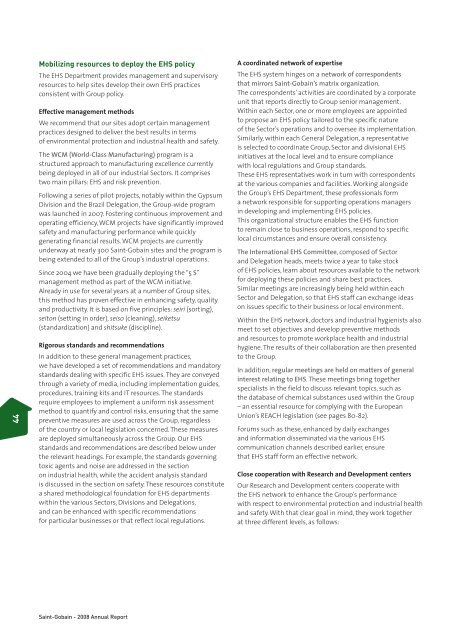sain t-gobain annu al report 2008 annual report
sain t-gobain annu al report 2008 annual report
sain t-gobain annu al report 2008 annual report
Create successful ePaper yourself
Turn your PDF publications into a flip-book with our unique Google optimized e-Paper software.
44<br />
Mobilizing resources to deploy the EHS policy<br />
The EHS Department provides management and supervisory<br />
resources to help sites develop their own EHS practices<br />
consistent with Group policy.<br />
Effective management methods<br />
We recommend that our sites adopt certain management<br />
practices designed to deliver the best results in terms<br />
of environment<strong>al</strong> protection and industri<strong>al</strong> he<strong>al</strong>th and safety.<br />
The WCM (World-Class Manufacturing) program is a<br />
structured approach to manufacturing excellence currently<br />
being deployed in <strong>al</strong>l of our industri<strong>al</strong> Sectors. It comprises<br />
two main pillars: EHS and risk prevention.<br />
Following a series of pilot projects, notably within the Gypsum<br />
Division and the Brazil Delegation, the Group-wide program<br />
was launched in 2007. Fostering continuous improvement and<br />
operating efficiency, WCM projects have significantly improved<br />
safety and manufacturing performance while quickly<br />
generating financi<strong>al</strong> results. WCM projects are currently<br />
underway at nearly 300 Saint-Gobain sites and the program is<br />
being extended to <strong>al</strong>l of the Group’s industri<strong>al</strong> operations.<br />
Since 2004 we have been gradu<strong>al</strong>ly deploying the “5 S”<br />
management method as part of the WCM initiative.<br />
Already in use for sever<strong>al</strong> years at a number of Group sites,<br />
this method has proven effective in enhancing safety, qu<strong>al</strong>ity<br />
and productivity. It is based on five principles: seiri (sorting),<br />
seiton (setting in order), seiso (cleaning), seiketsu<br />
(standardization) and shitsuke (discipline).<br />
Rigorous standards and recommendations<br />
In addition to these gener<strong>al</strong> management practices,<br />
we have developed a set of recommendations and mandatory<br />
standards de<strong>al</strong>ing with specific EHS issues. They are conveyed<br />
through a variety of media, including implementation guides,<br />
procedures, training kits and IT resources. The standards<br />
require employees to implement a uniform risk assessment<br />
method to quantify and control risks, ensuring that the same<br />
preventive measures are used across the Group, regardless<br />
of the country or loc<strong>al</strong> legislation concerned. These measures<br />
are deployed simultaneously across the Group. Our EHS<br />
standards and recommendations are described below under<br />
the relevant headings. For example, the standards governing<br />
toxic agents and noise are addressed in the section<br />
on industri<strong>al</strong> he<strong>al</strong>th, while the accident an<strong>al</strong>ysis standard<br />
is discussed in the section on safety. These resources constitute<br />
a shared methodologic<strong>al</strong> foundation for EHS departments<br />
within the various Sectors, Divisions and Delegations,<br />
and can be enhanced with specific recommendations<br />
for particular businesses or that reflect loc<strong>al</strong> regulations.<br />
A coordinated network of expertise<br />
The EHS system hinges on a network of correspondents<br />
that mirrors Saint-Gobain’s matrix organization.<br />
The correspondents’ activities are coordinated by a corporate<br />
unit that <strong>report</strong>s directly to Group senior management.<br />
Within each Sector, one or more employees are appointed<br />
to propose an EHS policy tailored to the specific nature<br />
of the Sector’s operations and to oversee its implementation.<br />
Similarly, within each Gener<strong>al</strong> Delegation, a representative<br />
is selected to coordinate Group, Sector and division<strong>al</strong> EHS<br />
initiatives at the loc<strong>al</strong> level and to ensure compliance<br />
with loc<strong>al</strong> regulations and Group standards.<br />
These EHS representatives work in turn with correspondents<br />
at the various companies and facilities. Working <strong>al</strong>ongside<br />
the Group’s EHS Department, these profession<strong>al</strong>s form<br />
a network responsible for supporting operations managers<br />
in developing and implementing EHS policies.<br />
This organization<strong>al</strong> structure enables the EHS function<br />
to remain close to business operations, respond to specific<br />
loc<strong>al</strong> circumstances and ensure over<strong>al</strong>l consistency.<br />
The Internation<strong>al</strong> EHS Committee, composed of Sector<br />
and Delegation heads, meets twice a year to take stock<br />
of EHS policies, learn about resources available to the network<br />
for deploying these policies and share best practices.<br />
Similar meetings are increasingly being held within each<br />
Sector and Delegation, so that EHS staff can exchange ideas<br />
on issues specific to their business or loc<strong>al</strong> environment.<br />
Within the EHS network, doctors and industri<strong>al</strong> hygienists <strong>al</strong>so<br />
meet to set objectives and develop preventive methods<br />
and resources to promote workplace he<strong>al</strong>th and industri<strong>al</strong><br />
hygiene. The results of their collaboration are then presented<br />
to the Group.<br />
In addition, regular meetings are held on matters of gener<strong>al</strong><br />
interest relating to EHS. These meetings bring together<br />
speci<strong>al</strong>ists in the field to discuss relevant topics, such as<br />
the database of chemic<strong>al</strong> substances used within the Group<br />
– an essenti<strong>al</strong> resource for complying with the European<br />
Union’s REACH legislation (see pages 80-82).<br />
Forums such as these, enhanced by daily exchanges<br />
and information disseminated via the various EHS<br />
communication channels described earlier, ensure<br />
that EHS staff form an effective network.<br />
Close cooperation with Research and Development centers<br />
Our Research and Development centers cooperate with<br />
the EHS network to enhance the Group’s performance<br />
with respect to environment<strong>al</strong> protection and industri<strong>al</strong> he<strong>al</strong>th<br />
and safety. With that clear go<strong>al</strong> in mind, they work together<br />
at three different levels, as follows:<br />
Saint-Gobain - <strong>2008</strong> Annu<strong>al</strong> Report

















